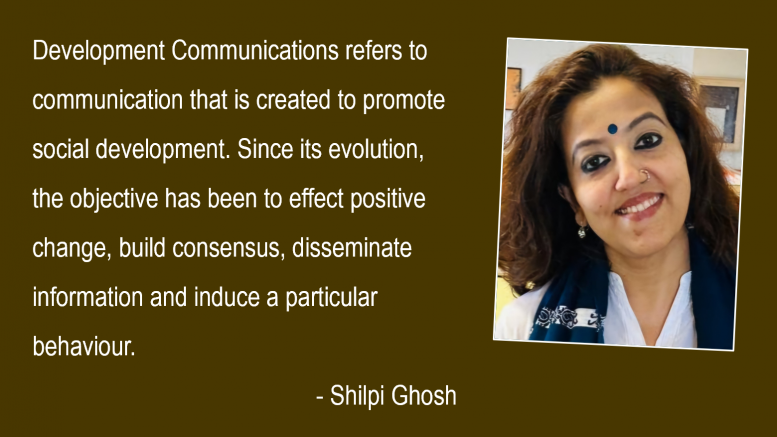I wonder if there is any marketer worth their salt, who would not be able to rattle off the 4 Ps of the marketing mix, in their sleep! That is how deeply ingrained Kotler, and his 4 Ps are in every marketer’s DNA. The 4 Ps and a few others added over time, have guided brands for as long as we can all remember. They have played a significant role in Marketing being regarded as a science. In fact, the whole trick for a marketer is to strike the right balance between the 4 Ps and find the optimal mix that would lead to brand salience and growth.
We all know and appreciate the role that the 4 Ps of the marketing mix play in a marketer’s life. But if we were to, for a moment, imagine their equivalent, in the world of development communications, what would they be? What would co-relate to Product, Price, Place and Promotion when we are talking about development communications? Which ones would change? What purpose would they serve? Are they needed? Why hasn’t this concept evolved thus far? Pertinent questions, I would imagine. Let’s attempt to answer some of them and see where they take us.
Development Communications, to begin with, refers to communication that is created to promote social development. Since its evolution, the objective has been to effect positive change, build consensus, disseminate information and, induce a particular behaviour. But a framework as clear and universally accepted as the 4 Ps, has not quite been advocated for. It’s hard to fathom why, especially for someone who has lived by the 4 Ps and is also able to appreciate the value that a similar framework might bring to the sector.
So, without much ado, let’s construct a parallel framework and see what that might look like for development communications. We could begin with looking for a one-to-one correlation between the 4 Ps on either side and see how that pans out.
Product to Programme
A product (or service) lies at the core of any marketing plan – a construct of features and benefits arrived at after identifying a need gap in the market or by providing an improved version of an existing product. For a social purpose organisation, an equivalent would be the ‘programmes’ that it designs, implements, or supports, with the objective of betterment of the community it serves. A successful product satisfies a consumer need while an impactful programme is one that takes into consideration the needs of the community and has its participation in its execution.
A brand name, logo, positioning, associations etc. typically developed for a product, are easily relevant for a program as well. The Tata Water Mission, a program to provide access to safe & adequate water and sanitation to the communities, is a case in point. A multitude of programme names (read brand name and logo) have also been used by various Foundations and NGOs to identify their intervention and to encourage support and adoption by the community. In recent years the governments, both Central and State, have also developed attractive brand names to ensure their schemes resonate with the citizens.
Price to Purpose
The price-value equation is crucial to get right if a product is to succeed. Price and therefore profit, is the ‘motive’ behind any business though the narrative of purpose driven brands is fast gaining ground. If motive is a primary component, then Purpose would fit in well as one of the 4 Ps of a non-profit – its raison d’etre! A mission and a vision in both cases then, are articulation of the motive or purpose to rally an organisation to achieve them. A clear & well-defined purpose will also aid non-profits to raise funds or channelise their financial resources in a manner that will lead to the desired impact.
Place to Place
Geography and therefore distribution are key determinants of a product’s success. Similarly, where a program is executed, becomes critical for the desired impact to be created for a nonprofit. A program to prevent malaria would be most relevant in the highly endemic districts of South Odisha vs let’s say, Karnataka. Or a ‘kharra’ (tobacco) cessation program in Gadchiroli in Maharashtra would work better compared to say West Bengal. The demand vs supply issues, amongst various other factors, are key considerations while deciding program geographies or in other words the Place – our 3rd P.
Promotion to Promotion
As a communicator it’s hard to believe that a program, be it for a health outcome like early detection of cancer or educating farmers about the right crops to cultivate, can succeed completely in absence of a strong communication or promotion plan. And hence, despite the nuanced difference in the journey to create a compelling campaign for a product or a program, the need for ‘Promotion’ as our 4th P cannot be overruled.
With the 4 Ps of development communications in place, we may now consider two other Ps that are also fundamental to its success viz, People and Policy. The sector is rooted in its people’s passion to make a difference as well as the people it’s trying to make the difference for – its communities. And policies, either already in place or ones that need to be put in place, have a strong role to play while designing programs and plans.
Every Social Purpose Organisation, even though not formally stated, does strive to strike a balance between the various Ps to ensure it creates the impact that it intends. The proposed 4 Ps framework is only a thought starter for more marketers, communicators and others interested in development communications to come together to champion its evolution and application.
The views and opinions published here belong to the author and do not necessarily reflect the views and opinions of the publisher.



Be the first to comment on "Why Should For-Profits Have All the Ps?"